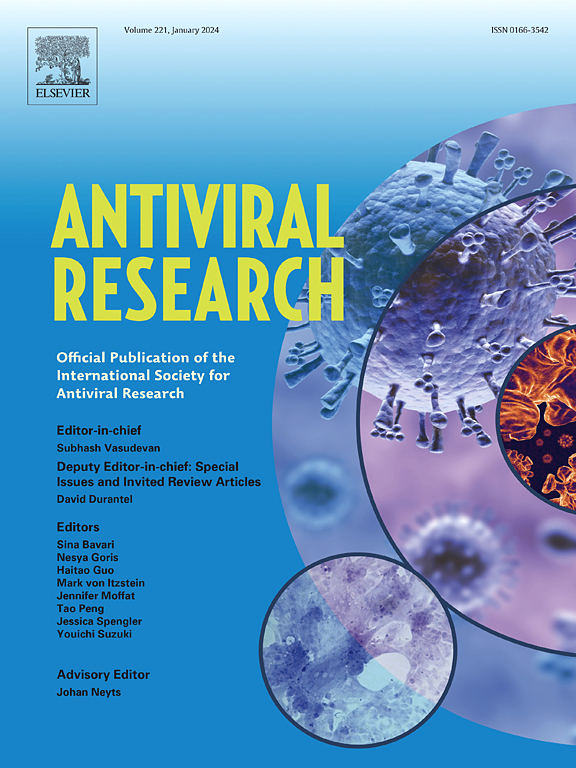Oral 3CL protease inhibitor ensitrelvir suppressed SARS-CoV-2 shedding and infection in a hamster aerosol transmission model
IF 4.5
2区 医学
Q1 PHARMACOLOGY & PHARMACY
引用次数: 0
Abstract
Severe acute respiratory syndrome coronavirus 2 (SARS-CoV-2) and coronavirus disease 2019 (COVID-19) remain a major global health challenge, with aerosol transmission being the primary route of spread. The use of antivirals as medical countermeasures to control SARS-CoV-2 transmission and spread is promising but remains to be clarified. The current study established and used an in vivo hamster aerosol transmission model system to evaluate the efficacy of the protease inhibitor ensitrelvir to prevent the spread of SARS-CoV-2. Male Index Syrian hamsters were intranasally infected with SARS-CoV-2, paired with naïve Contact hamsters, and co-housed for 12 h under conditions to allow for only aerosol transmission. The Index hamsters were treated three times with ensitrelvir starting 8 h post infection, or the Contact hamsters were treated once with ensitrelvir 12 h prior to co-housing. Viral infection and transmission were monitored by evaluating nasal lavage fluid, lung tissues, and body and lung weights. Post-infection administration of ensitrelvir to Index hamsters suppressed virus shedding in a dose-dependent manner. Pre-exposure administration of 750 mg/kg ensitrelvir to naïve Contact hamsters also protected against aerosol SARS-CoV-2 infection in a dose-dependent manner. Furthermore, pre-exposure treatment of 750 mg/kg ensitrelvir supressed body weight loss and lung weight increase of aerosol infected hamsters compared to vehicle-treated hamsters. These findings suggest that ensitrelvir may prevent SARS-CoV-2 spread when administered to infected patients and may prevent or limit SARS-CoV-2 infection when prophylactically administered to non-infected individuals. Both approaches may help protect at-risk individuals, such as family members living with SARS-CoV-2-infected patients.
口服 3CL 蛋白酶抑制剂 ensitrelvir 可抑制仓鼠气溶胶传播模型中 SARS-CoV-2 的脱落和感染。
严重急性呼吸系统综合症冠状病毒 2(SARS-CoV-2)和冠状病毒病 2019(COVID-19)仍然是全球健康面临的一大挑战,气溶胶传播是其主要传播途径。使用抗病毒药物作为医疗对策来控制 SARS-CoV-2 的传播和扩散前景广阔,但仍有待明确。本研究建立并使用了一个体内仓鼠气溶胶传播模型系统,以评估蛋白酶抑制剂 ensitrelvir 预防 SARS-CoV-2 传播的效果。雄性 Index 叙利亚仓鼠经鼻内感染 SARS-CoV-2,与天真接触仓鼠配对,在仅允许气溶胶传播的条件下共同饲养 12 小时。指数仓鼠在感染后 8 小时开始接受三次恩西特韦治疗,或接触仓鼠在共同饲养前 12 小时接受一次恩西特韦治疗。通过评估鼻腔灌洗液、肺组织以及身体和肺的重量来监测病毒感染和传播。疫点仓鼠感染后服用安赛列韦可抑制病毒脱落,其效果与剂量有关。天真的接触仓鼠在接触前服用 750 毫克/千克的恩西特韦,也能以剂量依赖的方式防止气溶胶 SARS-CoV-2 感染。此外,与用药物治疗的仓鼠相比,暴露前服用750毫克/千克恩西特韦可抑制气溶胶感染仓鼠的体重下降和肺重量增加。这些研究结果表明,对感染患者施用恩西特韦可防止 SARS-CoV-2 的传播,对非感染者预防性施用恩西特韦可防止或限制 SARS-CoV-2 的感染。这两种方法都有助于保护高危人群,如与 SARS-CoV-2 感染者生活在一起的家庭成员。
本文章由计算机程序翻译,如有差异,请以英文原文为准。
求助全文
约1分钟内获得全文
求助全文
来源期刊

Antiviral research
医学-病毒学
CiteScore
17.10
自引率
3.90%
发文量
157
审稿时长
34 days
期刊介绍:
Antiviral Research is a journal that focuses on various aspects of controlling viral infections in both humans and animals. It is a platform for publishing research reports, short communications, review articles, and commentaries. The journal covers a wide range of topics including antiviral drugs, antibodies, and host-response modifiers. These topics encompass their synthesis, in vitro and in vivo testing, as well as mechanisms of action. Additionally, the journal also publishes studies on the development of new or improved vaccines against viral infections in humans. It delves into assessing the safety of drugs and vaccines, tracking the evolution of drug or vaccine-resistant viruses, and developing effective countermeasures. Another area of interest includes the identification and validation of new drug targets. The journal further explores laboratory animal models of viral diseases, investigates the pathogenesis of viral diseases, and examines the mechanisms by which viruses avoid host immune responses.
 求助内容:
求助内容: 应助结果提醒方式:
应助结果提醒方式:


